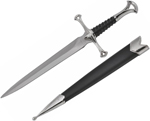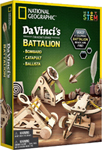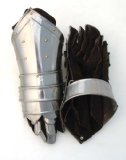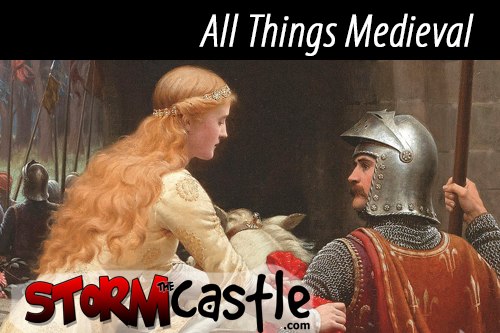
.
This is the medieval section of StormTheCastle.com
- Knights
- Castles
- Games
- Weapons/Armor
- Articles
- Medieval Names
- Medieval Words
- Medieval Terms
- Medieval Jobs
- Medieval Maps
Wills Books
All about medieval armor
The Term "Medieval Armor" covers a lot of territory.
. It pretty much spans most of the world and a very long period of time. This article covers Europe through the two stages of its Medieval Period; the Early Medieval period which was from 1066 to about 1299 and the Late Medieval Period from 1300 to 1600. Armor follows along with the political, spiritual, and technological advances that Europe went through during these times. And it played an integral part of the development. It was an important part of an arms race that grew, developed and got more complex. As an example of this we can look at the craft of metal working. As blacksmiths could make better weapons that were stronger and more resilient it was necessary to make armor that was stronger yet lighter. And this further spurred on the art of blacksmithing and the need to make even stronger and lighter weapons. This arms race wasn't just in the strength and durability of weapons it also affected the design of weapons. Percussive weapons like maces and hammers were very effective against chainmail which spurred on the development of plate armor. Armor, which was difficult to penetrate brought about a rise in thinner and sharper weapons that could pierce or find openings between plates. This development came about with the increasing ability of forging better weapons. The Medieval Periods were an interesting time in the development of Medieval armor.
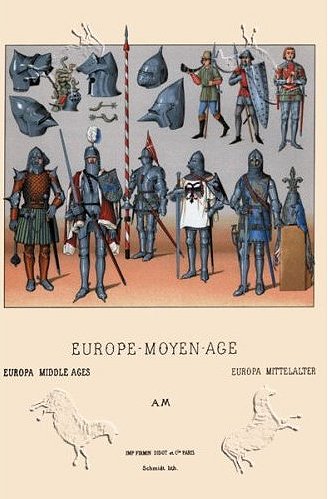
Art Poster, An Assortment of Medieval Armor, c.1350-1460 - 18.75 x 27.5
The Early Medieval Period
Medieval Armor in the 11-12th Centuries
The 11th Century was a time of big change in the history of Europe. It was coming out of the Dark Ages and ntering the Middle Ages. There were several times of armor that were most common during the 11th century. Platemail wasn't in use yet and the most common type of armor for the chest and the torso was something called a mail Hauberk. This was a garment that covered the torso and usually reached down to about the knees. It was made of a series of rings that were stitched or riveted together and armor made from this technique is called "Chain Mail". Hauberks were also, although less commonly, made of a series of overlapping metal scales that were sewn or stitched together and it is speculated that this configuration was riveted to some type of undergarment. The picture and product to the left is an example of a chainmail hauberk. It also shows another aspect of medieval chainmail armor: the coif. The coif was a chainmail piece of armor that was worn on the head. In the early centuries it was worn along but as the 12th century came around it was often worn under a helmet.
Armor for the Head: The helmet is of course one of the oldest types of armor. It has been around for many centuries 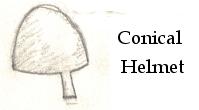 and it has developed dramatically over that time. The Spangenhelm was used extensively in the centuries before the 11th but it was still very much in use. It was composed of sevaral strips of iron or some other metal that were riveted into a helmet shape and then the spaces in between the strips were filled with sheets of metal or other material. Often the plates were composed of layers of metals like copper or bronze. Another type of helmet in use during the 11th century was the conical helmet. It was composed of a single sheet of iron that was hammered and shaped into a half cone that sat on the head. It sometimes had a piece of iron that extended down to cover the bridge of the nose.
and it has developed dramatically over that time. The Spangenhelm was used extensively in the centuries before the 11th but it was still very much in use. It was composed of sevaral strips of iron or some other metal that were riveted into a helmet shape and then the spaces in between the strips were filled with sheets of metal or other material. Often the plates were composed of layers of metals like copper or bronze. Another type of helmet in use during the 11th century was the conical helmet. It was composed of a single sheet of iron that was hammered and shaped into a half cone that sat on the head. It sometimes had a piece of iron that extended down to cover the bridge of the nose.
Armor for the legs: The legs of a mounted knight were very vulnerable so some armor was developed early for this part of the body and this took the form of chausses which were chainmail leggings. These first started to appear around the middle of the 12th century.
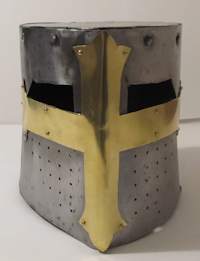
The GreatHelm - Is one of the more iconic types of helmets. I have a tutorial showing how to make one out of steel. You can check out that tutorial on my youtube channel right here. Forge a medieval GreatHelm
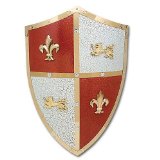
The Shield: The Traditional form of warriors shield throughout the latter part of the dark ages was circular or occasionally oval. Usually not larger than 3 feet in diameter and made of wooden planks laid next to each other. The surface frequently covered with leather and painted. Typically a hole was cut in the center and an iron grip put in and this covered by a shield boss. The Normans used a variation of shield called a Kite shield. It was larger and shaped like an upside down tear drop. I have more medieval shields here And I have a history of the Medieval Shield here
Medieval Armor of the 13th Century -
| Cuisses = | Thighs |
| Greaves = | Lower Legs |
| Poleyns = | Knees |
| Couters = | Elbows |
Much of the armor was a refinement of the armor of previous centuries. Chain Hauberks were still the common chest armor and helmets were common but with many variations in shape and size.Plate armor started to make its first appearances during this century. These weren't large plates for the chest area but rather they were plates covering the
extremities like arms and legs. A garment was added under the armor. It was a quilted and padded garment called a gambeson. One of the important developments in medieval armor during this century was the expansion to covering of more of the body. It is during this century that the Greaves or 'leg guards' for lower legs, cuisses for the thighs, poleyns for the knees and coters for the elbows made their appearance. It is toward the end of this century that metal gauntlet hand covering first came into use, replacing mail gauntlets. And the common kite and circular shield were often replaced by the heater shield which was smaller and less cumbersome. Toward the end of the 13th century the surcoat came into use. This was a sleeveless cloth gown that a knight wore over his armor.
Armor for Horses: It is during this century that armor started to be put on horses. This was typically made up of plates of leather and metal.
The late Medieval Period
The 14th Century
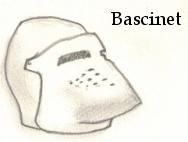 Helmets continued to develop into the late period and to defend against heavier and more effective weapons they tended to get more curved so blows would glance off them and often had a hinged visor that could be lifted. The bascinet is a good example of this kind of advanced helmet. Great helms were used during this period and they were large helms that could be worn right over the bascinet which provided another layer of protection.
Helmets continued to develop into the late period and to defend against heavier and more effective weapons they tended to get more curved so blows would glance off them and often had a hinged visor that could be lifted. The bascinet is a good example of this kind of advanced helmet. Great helms were used during this period and they were large helms that could be worn right over the bascinet which provided another layer of protection.
Body Armor: There were a variety of body armor types that were used during this period and chain was still in use but the transition continued to plate armor with more and more plate armor being worn. By the end of this century plate armor was worn more than chain. Because full plate was still expensive and difficult to make the most common type of body armor during this period was called the Coat of Plates. it was a series of plates both front and back attached to a cloth or leather garment. It is at the end of this century that the full metal breast plate started to make its appearance. And the movement toward complete sets of armor continued with the addition of plate shin guards known as demi-greaves and sabatons to cover the feet. Plate armor for the arms came into use during this century and this piece of armor was called vambraces and it was composed of armor for the upper arm called the upper canon and armor for the lower arm called the lower canon.
The 15th Century
It is during this century that the art and craft of Medieval Armor reached its highest point. When you think of a knight fully clad in plate armor this is the century that you are thinking of. And plate armor was brought to high art of different types in various countries. The full set of armor came fruition with every part of the body carefully covered by plate that still allowed for motion.
The helmet continued to be developed and refined and a very popular type of helmet during this century was the Barbut. It was similar to the Greek Corinthian helmet in that it had a T shaped opening in the front for vision and breathing.
As plate armor got to be more wide spread and more readily available it develop distinct difference among different countries. In Germany it developed into a style called Gothic because of its finely pointed extremities and gracious curves. Italian armor also developed some distinctions such as the armor of the sword arm being lighter to accomodate the sword or lance. And because plate armor was so effective the shield fell into disuse and the couter (elbow plate) of the shield arm was made larger to compensate for the loss of shield. Going forward into the 16th cen tury armor was raised to an art form that often took on styling of the times and it came in many variations. There was armor for combat and armor for tournaments. This was even developed further to armor that had interchangeable parts that could be substituted depending on the use it would see.
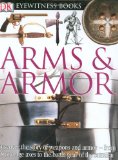
Arms & Armor (DK Eyewitness Books)
In a world where even toy guns are reviled by pacifistic parents there exists the extraordinary Eyewitness Book Arms & Armor . Studying weaponry is an unusual, fascinating angle on human history, as people have always used weapons to hunt, defend themselves, or attack. This intriguing photo essay examines the design, construction, and use of hand weapons and armor--from the Stone Age axe to the revolvers and rifles of the Wild West.
In the tradition of the Eyewitness series, Arms & Armor begins with a short introduction to prehistoric weapons, accompanied by a photograph-rich spread with fascinating, history-packed, fun-fact-loaded captions. The Los Angeles Times Book Review says the Eyewitness Books are "like a mini-museum between the covers of a book," and they are right! From crude Paleolithic hand axes, we progress to missile weapons; the first warriors (and the effect of the discovery of copper and bronze on tools and weapons); the weapons of the armies of ancient times; weapons from the Dark Ages; European swords; crossbows versus longbows; axes, daggers, and knives; plate and mail armor; Indian warriors; Japanese samurais; early firearms; flintlock firearms; dueling swords; dueling pistols ("Although illegal, for centuries dueling was a popular way for 'gentlemen' and army officers to settle their quarrels," the section begins); bizarre, extraordinary, seemingly impractical hand weapons; grenadiers and cavalry; pistols; "Guns that won the West"; North American Indian weapons; and, believe it or not, more. This book is sure to find an audience with youngsters obsessed with knights and times medieval, art-history buffs, amateur historians, or anyone with a penchant for pistols. (Ages 9 to 12) --Karin Snelson --This text refers to an out of print or unavailable edition of this title.
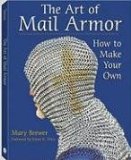
The Art Of Mail Armor: How to Make Your Own
Picture yourself in a full set of shining mail armor at your next reenactment, fair or costume party. And the best part is that you can say you made it yourself. The Art of Mail Armor shows you how to start with a piece of wire and end with a finished garment that costs a fraction of what it would ready-made and fits perfectly because it was custom made just for you. The book features seven original patterns from the author and step-by-step diagrams and instructions for attractive coifs (head coverings), hauberks (shirts), gauntlets, (gloves) and bishop's collars, as well as juggling balls, necklaces, belts, crosses and other jewelry. Find out how easy it is to assemble your tool kit and materials; acquire the best wire for specific items; measure for a perfect fit; join, enlarge, round, angle and fit sleeves; and incorporate decorative trimmings and inlays to make your designs truly unique. Also learn some quick and easy tricks for keeping your pieces clean and shiny - with no scrubbing or expensive commercial cleaners. Whether you are a Renaissance or medieval enthusiast, reenactor, historian, martial artist, jewelry designer or just someone with an interest in armor, you'll want to add this book to your library. Even experienced mail makers will find new ideas and techniques.
Some Medieval Items on Amazon for you
These are affiliate links, Will makes a small percentage of the sale
I have picked some best sellers for you
King Arthur Medeival short sword dagger - Medieval Chainmail Coif - DaVinci's Battalion
